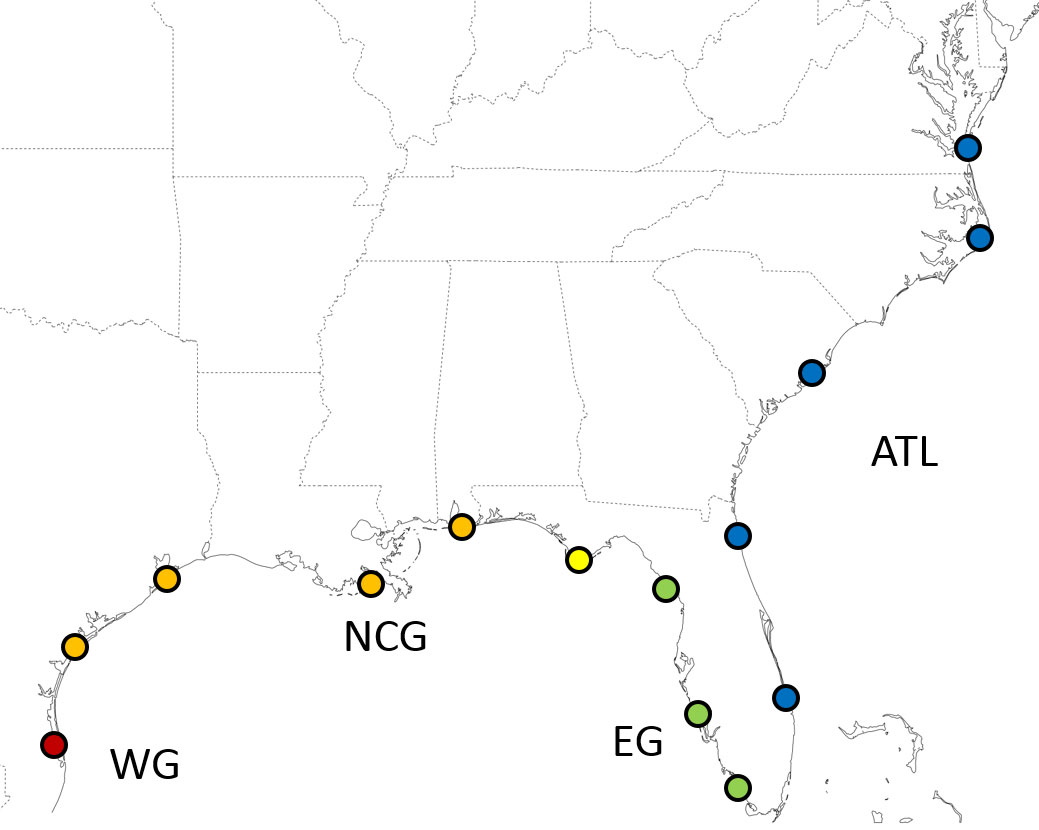Sheepshead Population Connectivity
Project Leader:Pearce Cooper
Project Details
Sheepshead, Archosargus probatocephalus: population connectivity and estuarine residency as inferred from population genomics and otolith chemistry
Background and summary of approach:
The study of population connectivity and subdivision is vital to the proper management and conservation of species and furthers the study of evolutionary biology and ecology. Sheepshead, Archosargus probatocephalus, are a euryhaline sparid fish that are ecologically, commercially, and recreationally important in the southeastern United States 1. Population genetic data (microsatellite genotypes) indicate genetic divergence in sheepshead across the tip of the Florida Peninsula and both morphologic and population genetic data indicate divergence across Apalachee/Apalachicola Bay in the Florida Panhandle 2. Divergence across Apalachee/Apalachicola Bay is not proximal to any known hydrographic barriers and may be maintained by divergent selection between the divergent environments/ecosystems of the fresher, turbid, and more productive north central Gulf of Mexico coastal waters and the salty, clear waters of the west coast of the Florida Peninsula. In collaboration with the Marine Genomics Laboratory at Texas A and M University Corpus Christi, we aim to re-examine sheepshead population structure using reduced representation genomics and more extensive geographic sampling to increase the resolution of neutral population structure (Figure 1) and make inferences on patterns of selection by partitioning out putatively selected loci using multiple methods of genomic outlier detection.
Sheepshead are euryhaline in that they are found from the offshore marine environment to the freshwater tidal reaches of rivers 1. Otolith chemistry has previously been used to describe salinity residency in euryhaline fishes as well as partition out potentially distinct life history contingents of a population within an estuary in terms of salinity residency 3-5. We aim to use the salinity tracers of Sr/Ca and Ba/Ca, coupled with experimental validation and water sampling, to make inferences on salinity residency in sheepshead sampled in Mobile Bay in the north central Gulf of Mexico as well Apalachicola Bay, which is within an introgression zone between the north central and eastern Gulf of Mexico sheepshead populations. As genomic data will be available for all these individuals, we will be able to examine not only whether or not there are distinct life history contingents in sheepshead but also whether or not there is any covariance between genomic data and apparent patterns of salinity residency in both an introgression zone and a single deme of sheepshead.
Objective(s): The objectives of this project are to:
(1) Examine gene flow across the managed range of sheepshead in high resolution (2) Examine patterns of directional selection across this range (3) Examine salinity residency of sheepshead in two major estuaries (4) Determine if there is any covariance between salinity residency and genomic data within an introgression zone and a single deme of sheepshead.

Sources
Vanderkooy SJ (2006) The Sheepshead Fishery of the Gulf of Mexico, United States. Gulf States Marine Fisheries Commission, Ocean Springs, MS. Seyoum S, McBride RS, Puchutulegui C, Dutka-Gianelli J, Alvarez AC, Panzner K. (2017). Genetic population structure of sheepshead, Archosargus probatocephalus (Sparidae), a coastal marine fish off the southeastern United States: multiple population clusters based on species-specific microsatellite markers. Bulletin of Marine Science, 93, 691-713. Walther BD, Limburg KE (2012) The use of otolith chemistry to characterize diadromous migrations. Journal of Fish Biology, 81, 796–825. Nims MK, Walther BD (2014) Contingents of southern flounder from subtropical estuaries revealed by otolith chemistry. Transactions of the American Fisheries Society, 143, 721–731. Elsdon TS, Gillanders BM (2005) Alternative life-history patterns of estuarine fish: barium in otoliths elucidates freshwater residency. Canadian Journal of Fisheries and Aquatic Sciences, 62, 1143–1152
Collaborators:
Fisheries Ecology Lab at the Dauphin Island Sea Lab and University of South Alabama Marine Genomics Lab at Texas A and M University-Corpus Christi
